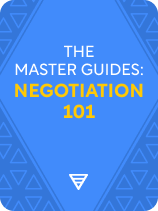

This article is an excerpt from the Shortform book guide to "The Master Guides: Negotiation" by Shortform. Shortform has the world's best summaries and analyses of books you should be reading.
Like this article? Sign up for a free trial here.
Are you well prepared for a negotiation? How do you make a good bargain that benefits both you and your opponent?
When you’re face-to-face at the negotiating table, you want to strike the best possible deal. Experts have great advice on how to take advantage of new information and how to use the Ackerman model to craft your offer.
Learn how to bargain by getting all the information you need to master the Ackerman model.
Take Advantage of Information
Chris Voss (Never Split the Difference) writes that in every negotiation, there is some hidden piece of information that, if it were known, would completely transform the dynamic of the negotiation and the final outcome. Voss writes that there are three types of information that will help you know how to bargain.
1) Known Knowns: These are the things you know for sure. In a negotiation, the known knowns are things like your counterpart’s name, their offer, and the knowledge gained from your experience in past negotiations.
2) Known Unknowns: This is information that you know exists but don’t possess yourself. In a negotiation, a known unknown might be your counterpart’s price ceiling (the highest amount they’re willing to pay) or her dealbreaker condition. You know she has these; you just don’t know what they are.
3) Unknown Unknowns: The most important pieces of information, according to Voss, are the unknown unknowns. These are the bits of information that we lack—and, crucially, don’t know that we lack. In a negotiation, those who can best identify and exploit the unknown unknowns are those who come out on top. For example, if you discovered that your counterpart was facing some sort of external financial pressure (from a lawsuit or a job loss), you would have crucial leverage over them, because this information would tell you that your counterpart would likely accept a heavily discounted offer.
Similarly, Deepak Malhotra and Max Bazerman (Negotiation Genius) write that it’s critical to seek out information that negotiators commonly overlook, such as:
- How the other side makes decisions. Your counterpart may be bound to specific decision-making rules, such as being required to weigh criteria differently or needing to get the approval of a supervisor. By discovering this, you can figure out how to meet these criteria in a way that’s most suitable for you.
- How strong the other side’s position is. Negotiators may overlook their competitor’s strengths or underestimate how much information they have. To avoid this, the authors recommend you deliberately consider what unique advantages your competitors may have.
Use the Ackerman Model to Craft Your Offer
Voss (Never Split the Difference) recommends what he calls the Ackerman Model as a good alternative to traditional negotiating. Created by ex-CIA operative Mike Ackerman (who later founded a company advising law enforcement on kidnapping situations), this model is based on the offer-counteroffer system. It uses a tapering system that brings the ultimate number (whether it’s the price you’ll be paying or the price you’ll be receiving) closer to your preference.
Voss writes that the Ackerman Model improves on the traditional “split the difference” approach, which tends to produce a mutually dissatisfying result.
Below, we’ll explore some of the key steps in the Ackerman model.
1) Choose a Target Price
This should be ambitious, but reasonable. You don’t want to negotiate with yourself and set your target price too high (if you’re the buyer), but you also don’t want to set it so low that your counterpart would never agree to it. Doing some research beforehand will help you set your goal. William Ury and Roger Fisher (Getting to Yes) similarly caution against starting with an unreasonable position, as it can set off a struggle of wills with each side trying to force its position on the other. This leads to mounting anger and resentment—and if the bad feelings linger, it can become hard to reach a deal.
2) Offer 65% of Your Target Price
Thus, if you’re aiming to pay $100,000, your opening bid should be $65,000. This is a starting bid designed to catch your counterpart off guard. Voss writes that an extreme starting bid like this can also trigger your own sense of loss aversion in a constructive way. By starting with a low offer, you’ll start thinking of anything higher than that as a “loss,” which you’ll work hard to avoid. In reality of course, you’re still well below your target price at this point, so even if you move off your opening bid it’s still a “win” for you.
3) Plan Your Counteroffers
When planning your counteroffers, use three increases—but each time, reduce the size of the increase. For example, Voss recommends countering at first with a number that’s 85% of your target price (a 20 percentage-point jump). Then, you increase it to 95% of your target price (only a 10 percentage-point jump this time). If they’re still not accepting this, then finally you meet them at your full target price (which by this point is a modest 5 percentage-point jump).
All of this activates your counterpart’s emotional instinct to be fair, reasonable, and reciprocal. Most people, writes Voss, are naturally inclined to match what they see as generosity toward themselves with generosity of their own toward others—indeed, most people don’t want to feel like they’re freeloaders. So when they see you making what appear to be concessions (even though you’re only really going up to your actual target price), they’ll be more likely to want to match that “generosity” with generosity of their own.
4) Signal When You’ve Reached Your Limit
Voss recommends including a non-monetary item along with your final offer to signal that you’re truly at your limit. For example, after you’ve made your final offer in a salary negotiation, you might signal that this is your final offer by shifting the discussion to other elements of the job, like your title, flexible work schedule, and office location. By pivoting to something other than money, you’re sending a message to your counterpart that the monetary portion of the negotiation is over, and you’re ready to move on to other items.

———End of Preview———
Like what you just read? Read the rest of the world's best book summary and analysis of Shortform's "The Master Guides: Negotiation" at Shortform.
Here's what you'll find in our full The Master Guides: Negotiation summary:
- How we're always negotiating, even if we don't realize it
- A synthesis of ideas and recommendations from leading negotiation experts
- A look into two different approaches to negotiation: emotional and rational






